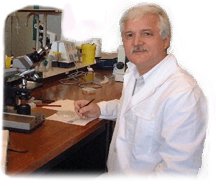
|
|
|
|
|
|
NEW JERSEY INDOOR ENVIRONMENTAL SCIENCES
|
||
|
973-726-9559
|
||
| Professor MJ Dvmanov from the Mycological Institute FMHH reviews the recent research study by Dr. Mahmoud Ghannoum, Ph.D. from t the Center for Medical Mycology at University Hospitals Case Medical Center has shown that toenail fungus and athlete's foot can spread from person to person living in the same household. Athlete's foot is usually caused by anthropophile fungi a type of fungi or mold that has an affinity for human tissue. The most common species are Microsporum, Epidermophyton and Trichophyton. These account for 90 per cent of all skin fungal infections, commonly referred to as ringworm.. The Professor comments " this belief was common among medical mycologists but the recent study final confirms this and is now available to the general public. It is common knowledge that the Aspergilli are a the pathogen in onychomycosis (infection of toenails) and especially "terrus". What this also does it to support the institute's position that the regular application of fungicides must be applied in common areas where people expose their feet such as the gym, showers and locker rooms and other areas where the athlete my find themselves bare foot. This is just as true for schools and adult heath centers and gyms. | ||
|
Researchers Demonstrate That Toenail Fungus and Athlete's Foot Spread From Person to Person SAN FRANCISCO, Sept. 29 /PRNewswire/ -- Popular wisdom has long held that the common infections toenail fungus and athlete's foot can spread from person to person. But science now confirms this belief. Led by Mahmoud Ghannoum, Ph.D., researchers at the Center for Medical Mycology at University Hospitals Case Medical Center have shown that toenail fungus and athlete's foot can spread from person to person living in the same household. Conducted at five research centers, the study brought together experts in dermatology, epidemiology and mycology.
Affecting more than 35 million people, toenail fungus (onychomycosis) is a common, chronic, and highly persistent fungal infection in which affected nails become discolored, brittle, thickened, and flaky. Toenail fungus often results from tinea pedis, another common fungal skin infection commonly called athlete's foot that affects 10% of the general population. Toenail fungus and athlete's foot are caused by tiny organisms called dermatophytes; the most common dermatophytes are Trichophyton rubrum (T. rubrum), Trichophyton mentagrophytes (T. mentagrophytes), and Epidermophyton floccosum (E. floccosum). "Doctors have never been able to caution patients with certainty that toenail fungus or athlete's foot can spread from one family member to another," noted Dr. Ghannoum. "Our findings have important implications regarding the need to treat toenail fungus and tinea pedis to help prevent their spread." The study enrolled 57 families in which at least one member, the "index person," had either toenail fungus and/or athlete's foot. Of these, 19 families were identified in which at least two members were infected. Using conventional and culture growth methods to examine toenail and skin samples from every participant, researchers determined that the vast majority of infecting fungus (80.4%) were of the T. rubrum species, while most of the others were infected with T. mentagrophytes. The identity of each species was confirmed using a molecular technique in which a fragment of DNA is amplified millions of times. These DNA molecules were further analyzed using another sophisticated molecular biology technique called restriction fragment length polymorphism (RFLP). Using both techniques, researchers were able to determine the specific identity of each strain. Results showed that among 42% (8/19) of families, identical dermatophytes were transmitted between at least two members. Of these families, 87.5% (7/8) were infected with the most common strain T. rubrum. Matching the DNA of dermatophytes among members of the same household confirmed that the infection had spread from one family member to the other either directly or indirectly. Responses to a questionnaire showed that the likelihood of the spread of infection within a household was influenced mainly by the strain of fungus and whether anyone in the family had nail discoloration or scaling of the skin on the side of the foot, as well as members' past history of toenail fungus and athlete's foot. "This study raises questions we will look at in the future," noted Dr. Ghannoum. "For instance, why did the infection spread among some families but not others, and why did some members of a household become infected while others did not. When we can answer these questions, we will be closer to knowing how to eradicate these very common and highly persistent infections. But what we can see from the current findings is the value of treating toenail fungus and athlete's foot to try to prevent its spread from person to person." The study was supported by funding from Novartis Pharmaceuticals. Other lead authors on the paper included William Halsall, Pranab Mukherjee, Ph.D. and Neil Korman, M.D. who are at University Hospitals of Cleveland, as well as Erin Warshaw, M.D. from University of Minnesota and Minneapolis VA Medical Center, and Amir Tavakkol, Ph.D. of Novartis. With 150 locations throughout Northeast Ohio, University Hospitals serves the needs of patients through an integrated network of hospitals, outpatient centers and primary care physicians. At the core of our Health System is University Hospitals Case Medical Center. The primary affiliate of Case Western Reserve University School of Medicine, University Hospitals Case Medical Center is home to some of the most prestigious clinical and research centers of excellence in the nation and the world, including cancer, pediatrics, women's health, orthopedics and spine, radiology and radiation oncology, neurosurgery and neuroscience, cardiology and cardiovascular surgery, organ transplantation and human genetics. Its main campus includes the internationally celebrated Rainbow Babies & Children's Hospital, ranked best in the Midwest and first in the nation for the care of critically ill newborns; MacDonald Women's Hospital, Ohio's only hospital for women; and Ireland Cancer Center, which holds the nation's highest designation by the National Cancer Institute of Comprehensive Cancer Center Source: University Hospitals Case Medical Center |
||